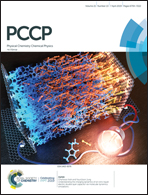Electronic and structural features of octa-coordinated yttrium–ammonia complexes: the first neutral solvated electron precursor with eight ligands and three outer electrons†
Abstract
The neutral and charged yttrium metal–ammonia complexes, [Y(NH3)8]0,±, are investigated using state-of-the-art quantum chemical calculations. The electronic structure of these complexes is described as an Y(NH3)83+ core with two, three, and four electrons orbiting in its periphery. Unlike the so far reported solvated electron precursors containing alkali, alkaline earth or first-row transition metals, yttrium complexes are the only ones which can accommodate eight ammonia ligands and up to four peripheral electrons. For the neutral species, two electrons occupy the diffuse s-type orbital (1s) and one diffuse p-type orbital (1p). For the cationic counterpart one electron is removed from the 1p orbital, while for the anion another electron is added to the 1p shell. The calculated low-lying electronic states with excitation energies up to 2.0 eV populate the 1s, 1p, and 1d outer orbitals. The first ionization energy of Y(NH3)8 is 2.74 eV and its electron affinity is 0.64 eV. The present results suggest that saturated yttrium ammonia solutions will turn into solids (liquid or expanded metals), where a grid of Y(NH3)83+ centers will be surrounded by “free” electrons.



 Please wait while we load your content...
Please wait while we load your content...